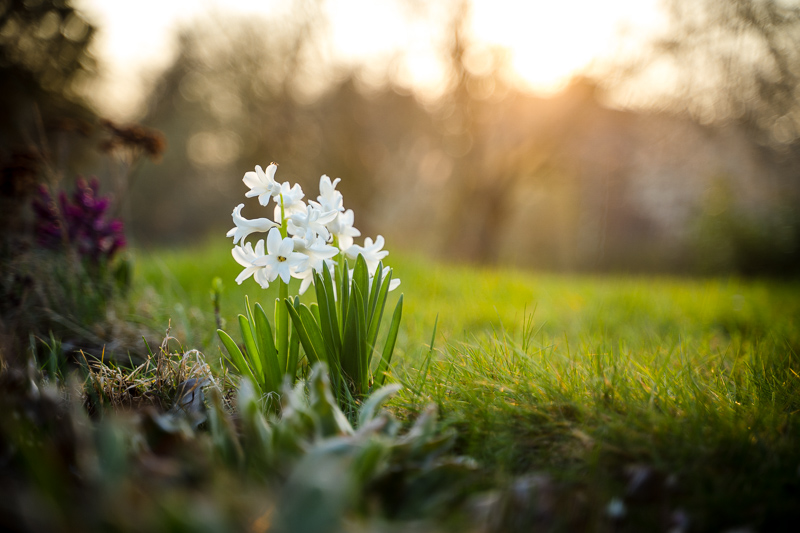
After analyzing the infinity sharpness of the candidates in Part 1 of this series, we are looking at the opposite direction of the focus ring. For a versatile do-it-all standard zoom lens, the macro capability is an important factor of the overall performance. Details in documentation-, wedding-, product-, nature- or food photography are typical applications for a standard zoom as a pseudo-macro. In photographic history, the macro feature of zoom lenses was often a shameful marketing trick without any serious usefulness. Let’s check out the performance of the of the Sony FE 2.8/24-70 GM, Tamron 2.8/28-75 Di III RXD and the Sony FE 4/24-105 G OSS.
General Macro Capability
The chart below demonstrates what magnification the three lenses can provide at their extreme focal lengths.
Sony 2.8/24-70 GM: Nothing remarkable, Low magnification at the wide end, higher magnification at the long end.
Tamron 2.8/28-75 Di III RXD: Very comparable to the GM at the long end but great magnification at the short end. Having useful magnifications at the short and the tele side offers more creative possibilities. Take a look at the chest of the pilot at 28mm: It is very dark because the lens is so close that it shades the subject.
Sony 4/24-105 G OSS: Low magnification at the short end but good magnification at the long end. This combined with the longer focal length makes this lens the most useful for photography of larger insects like dragonflies or butterflies (or anything else that can run/fly away).
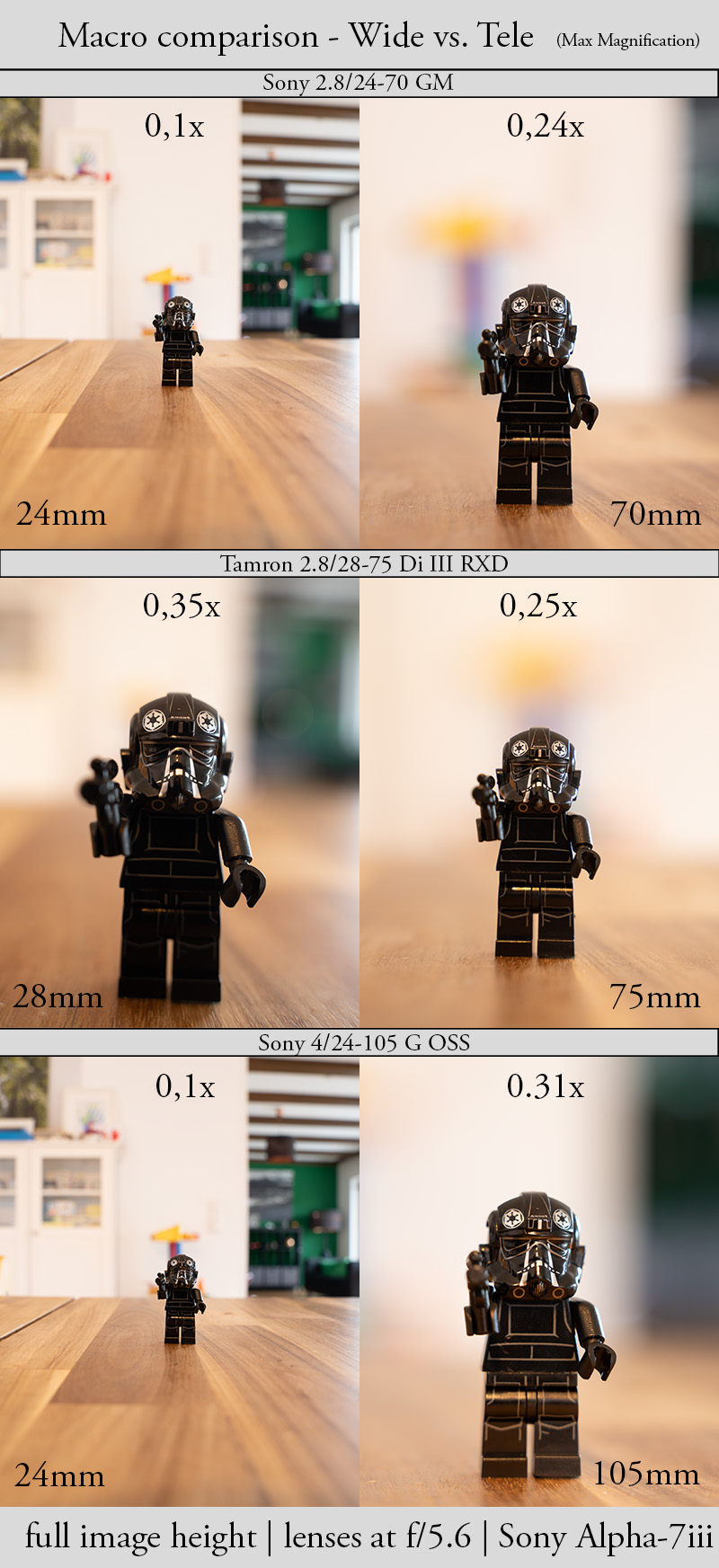
Image Quality
Having a lens with good magnification is worthless if the image quality can’t keep up with the crop of a lower magnification. This is especially true in times of accessible 42+ MP sensors and/or high resolution pixel shift modes in many high end bodies.
I took images of Text (alligned planar to the sensor) and looked at the sharpness of the focused area, the size of the sharp area (no lens was able to render the whole image circle sharp at MFD) and aberrations. Below you see 100% crops of the sharp area:
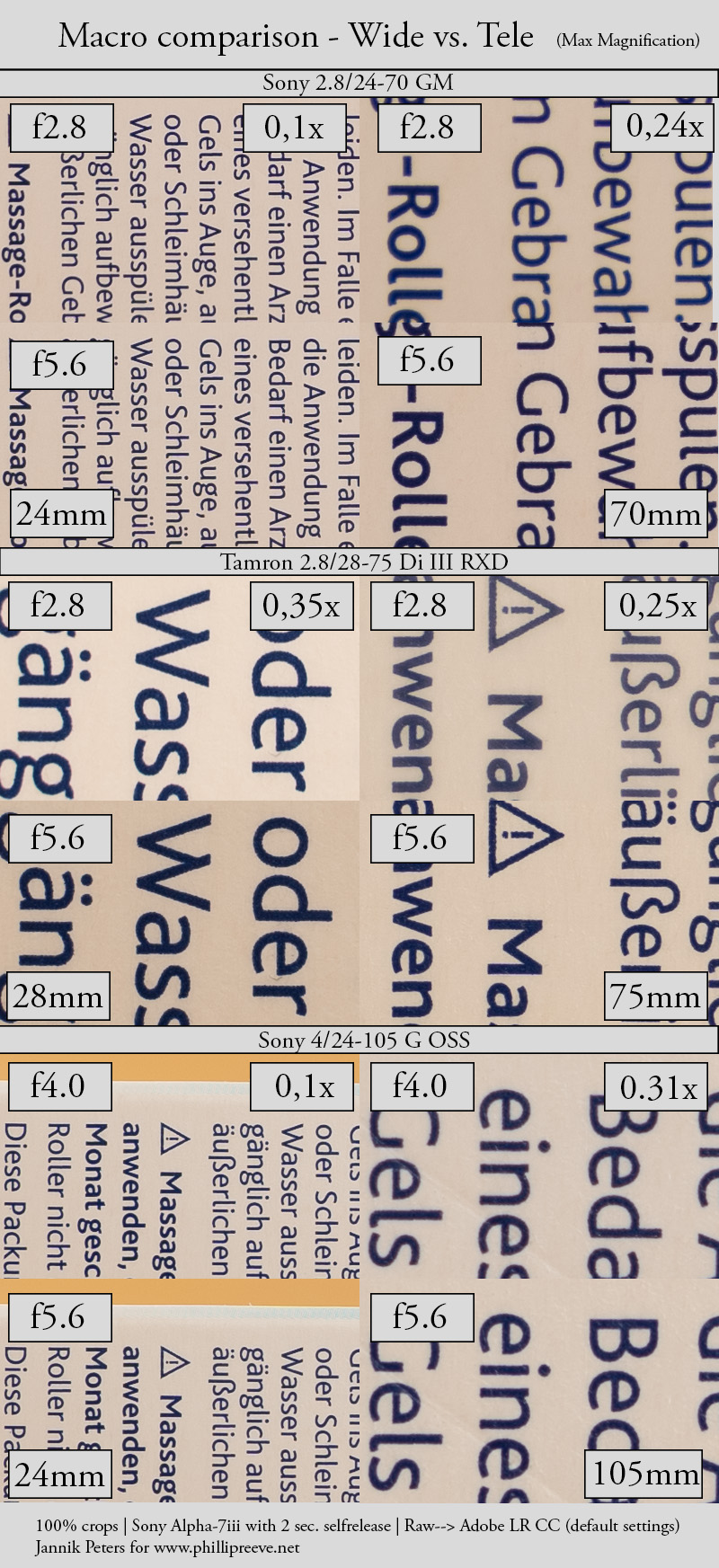
The table below shows my rating for the test:
| Subject | Sharpness in the focused spot | Size of the sharp area | Aberrations |
|---|---|---|---|
| Sony 2.8/24-70 GM, 24mm ,f2.8 | Very Good | Small | Low |
| Sony 2.8/24-70 GM 24mm, f5.6 | Excellent | Average | Low |
| Sony 2.8/24-70 GM, 70mm, f2.8 | Average | Average | Average outside of sharp area |
| Sony 2.8/24-70 GM 70mm, f5.6 | Very Good | Large | Low |
| Tamron 2.8/28-75, 28mm, f2.8 | Very Good | Small | High LaCA and SA outside of sharp area |
| Tamron 2.8/28-75, 28mm, f5.6 | Excellent | Average | High LaCA outside of sharp area |
| Tamron 2.8/28-75, 75mm, f2.8 | Good | Average | Low contrast, LaCA and SA outside of sharp area |
| Tamron 2.8/28-75, 75mm, f5.6 | Very Good | Large | LaCA outside of sharp area |
| Sony 4/24-105, 24mm, f4 | Very Good | Large | Low |
| Sony 4/24-105, 24mm, f5.6 | Excellent | Large | Low |
| Sony 4/24-105, 105mm, f4 | Average | Small | Low |
| Sony 4/24-105, 105mm, f5.6 | Good | Average | Low |
Sony 2.8/24-70 GM: Good image quality at MFD, low aberrations and useful sharpness.
Tamron 2.8/28-75 Di III RXD: Very sharp at 28mm but small area of sharpness and aberration plagued peripheral areas.
Sony 4/24-105 G OSS: Low aberrations and useful size of the sharp areas. Sharpness at the long end could be better though wide open.
Bokeh
Macro images almost neccesarily contain unsharp areas, so the quality of the bokeh is very important for the general perception of image quality. Furthermore, bokeh is still very subjective and a personal thing. For me, good bokeh means clean and smooth out of focus areas.
First let’s start with the general image impression. The scene below contains backlight waterdrops and is very demanding (many highlights and high contrast), a kind of worst case scenario. You see that the three lenses render differently, much more than the specs would make you expect. The potential subject isolation (at the same focal length) is of course larger with the f2.8 lenses. Nevertheless, depth of field is so thin at high magnification that this is not neccesarily important. Personally, I like “dreamy” looking images like the one in the header, so I still tend to use f2.8 even near MFD.
If we take a closer look (1:4 magnification is enough), we see more of the characteristics of their respective bokeh:
Sony 2.8/24-70 GM:
wide open: Slight outlining with chromatic aberrations wide open, slight onion ring structures, nice shape until the edges.
stopped down: Rough structures inside of the bokeh balls, outlining is more pronounced.
Tamron 2.8/28-75 Di III RXD:
wide open: Overcorrected SA with extremely bright outlining. Trioplan-“Qualities”. Oddly cut bokeh balls and chromatic aberrations towards the edges.
stopped down: Slight onion ring structures and chromatic aberrations towards the edges. Otherwise good bokeh quality.
Sony 4/24-105 G OSS:
wide open: Slight outlining, onion rings and chromatic aberrations. Bokeh balls are slightly distorted towards the edge.
stopped down: Outlining and onion rings are more pronounced.
As a bonus, I added the short end (28mm) of the Tamron 2.8/28-75 wide open and at f5.6. I think that the bokeh wide open is surprisingly good, especially after what we have seen at 75mm. The bokeh balls at the edge are cut off due to mechanical vignetting but the outlining is well controlled and contrast is low. Chromatic aberrations are visible in the outling at the edge. At f5.6, bokeh balls look more distorted as we know it from many wide angle lenses. Chromatic aberrations are also more pronounced. If depth of field allows, I prefer to shoot wide open.
Conclusion
The Tamron 2.8/28-75 looks like a macro specialist under the standard zooms on the paper. Can it live up to that in practical work? Mostly yes! Sharpness is useful at both ends. Macro images at 75mm and f2.8 have a odd characteristic that I dislike a lot. Low contrast of the subject and crazy outlining will be interesting for Trioplan lovers at best, I am not one of them. Stopping down to f5.6 tames the beast and turns this into a good macro option. What makes this lens special is the 28mm macro feature which is a very serious option when it comes to sharpness and rendering.
The Sony FE 4/24-105 G OSS takes the good second place in my personal order as it has the longest focal length and the highest magnification at the long end. It renders acceptably there and can be very useful for nature photography.
The Sony FE 2.8/24-70 GM does nothing special for me at macro distances although it keeps image quality and sharpness mostly under control which makes it still useful for documentary work.
If macro is your thing, getting a decent macro lens is a good idea anyway. Nevertheless, having macro capabilities within a twist of a zoom and a focus ring can be a useful addition for almost everybody.
The Sony 2.8/24-70 GM can be bought for $2.198 at Amazon.com (affiliate link), 2.199€ at Amazon.de (affiliate link).
The Tamron 2.8/28-75 Di III RXD can be purchased for $899 at Amazon.com (affiliate link) or 829€ at Amazon.de (affiliate link).
The Sony 4/24-105 G OSS can be bought for $1.398 at Amazon.com (affiliate link), 1.398€ at Amazon.de (affiliate link).
Go back to Part 1: Sharpness (infinity)
This site contains affiliate links. If you make a purchase using any of the links marked as affiliate links, I may receive a small commission at no additional cost to you. This helps support the creation of future content.
Jannik Peters
Latest posts by Jannik Peters (see all)
- A beginner’s guide to bird photography – Episode 1: Sharpening your senses - August 3, 2021
- Review: Tamron 35mm F/2.8 Di III OSD M1:2 - March 8, 2020
- Review: Zeiss Batis 2/40 CF after the Firmware Update - August 16, 2019

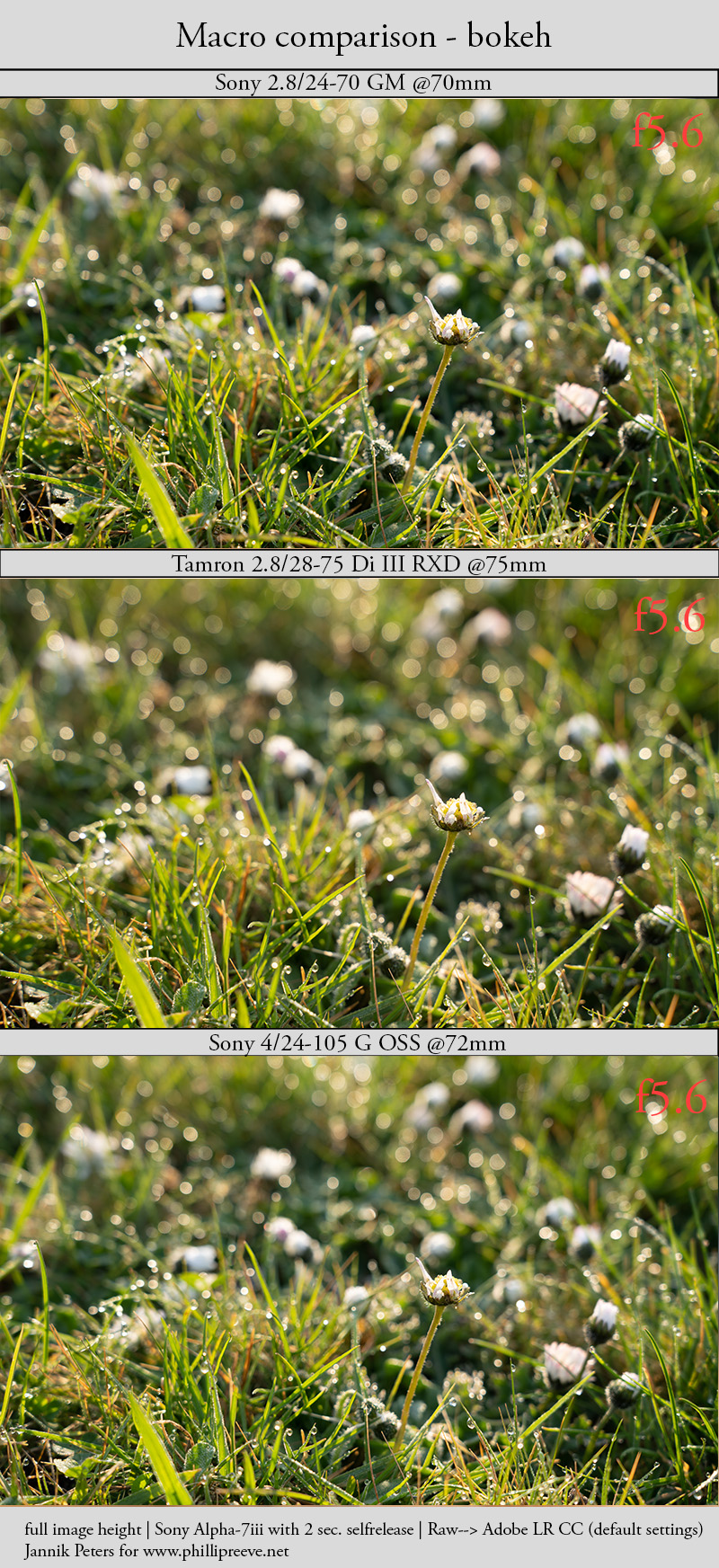
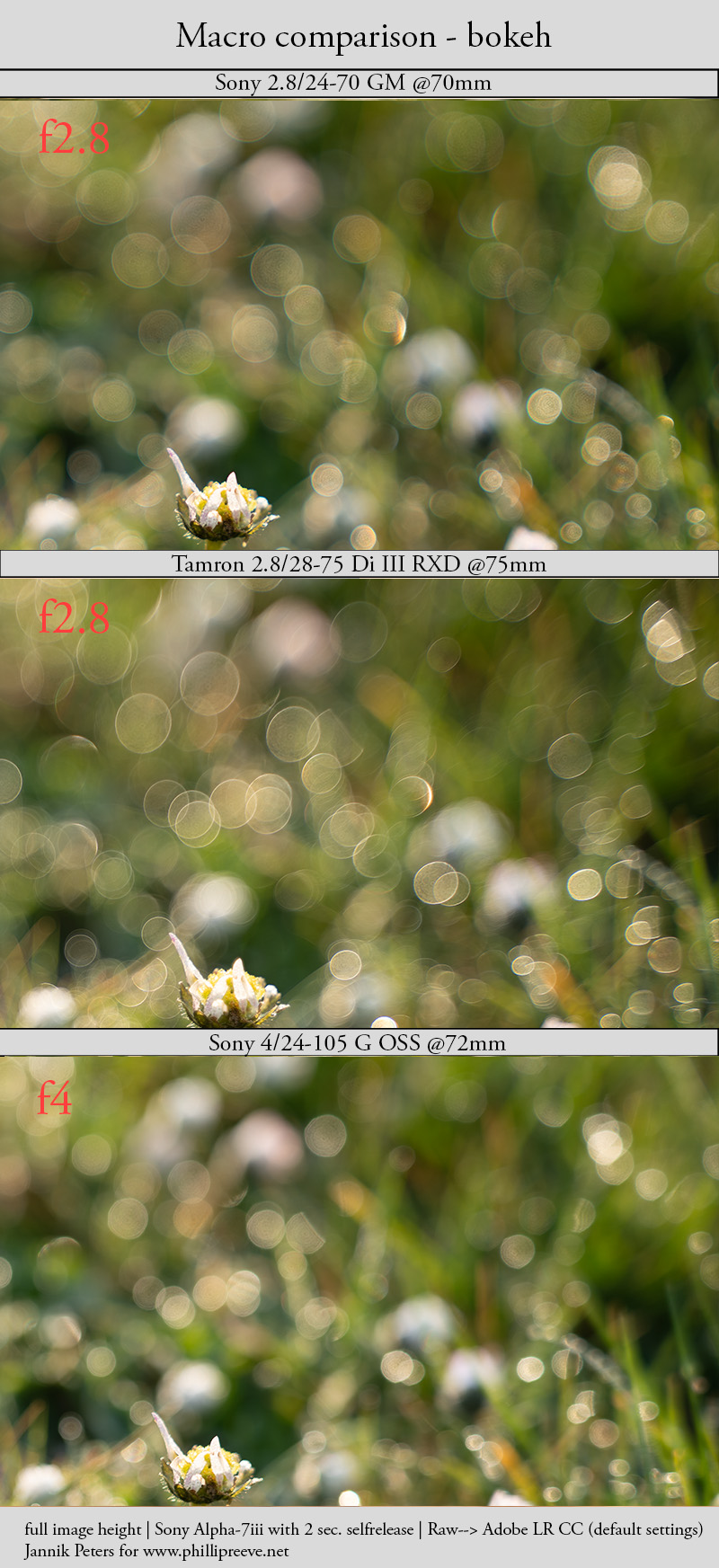
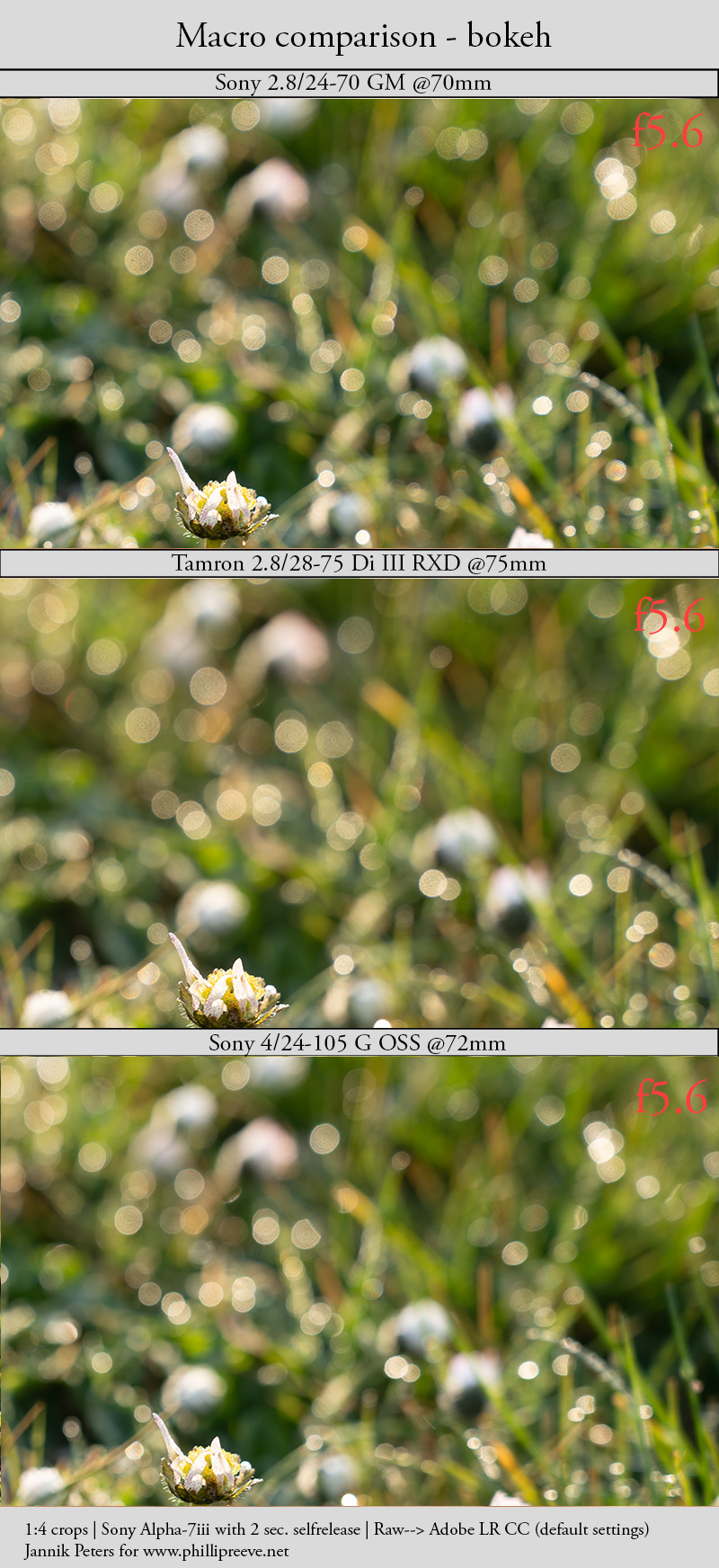


Interestingly in the pilot scene the Tamron at 75mm F2.8 seems to have much softer background than Sony GM, despite the similar magnification ratio! Is it because the Tamron actually has slightly longer actual focal length, or does it focus closer?
Yes, very interesting. Magnification is about the same, this can’t be the reason. Effective aperture may be different although I didn’t notice any stopping down by the aperture itself.
great review, but no big suprises.
Can bokeh be expected to be worst on the tamron at portrait distances too?
What about throwing the backround out of focus with 105mm@f4 vs 70/75mm@f2.8?
That’d be interesting for practical work as from DOF-Simulation i expect comparable bokeh (with more compression at 105mm ofc).
Thank you, this will be part of the next chapter 😉
looking forward then! 🙂
I really love the macro capability of the Tamron. I was generally happy with Sony 55 1.8, but its maximum magnification ratio was not impressive and it was my biggest complain. I think small, light, and high magnification ratio is kind of trademark of Tamron SP series.
I hoped Tamron would release their version of “MC-11″like adapter, but they decided to develop whole new product, and it was a mega hit. I hope 17-28mm or slower telephoto zoom has same kind of traits of the 28-75.
Thanks for the review!
I have exactly the same problem. Also I’ve not found anything in the 28-35mm range that really sits well with ithe 55/1.8, so the Tamron is very tempting for when I’m travelling.
Thank you for the review of this lens
LG Bernhard
By far my favorite bokeh is with the Tamron. Then again, as you suggested, I love my Trioplan, so make of that what you will. 🙂
Loving this series / review shootout!
The bokeh in particular is interesting , can’t wait for the next segment + keep up the great work 🙂
cheers
Thank you for good review
I’m using fe 50mm f2.8 macro for product video. Can tamron 28-75/2.8 replace that lens?
Looking forward to the next episode!
Thank you for putting all the effort into this, time consuming to say the least. Always enjoy your thoughts and impressions on lenses.
Sigma just enter the chat room**
looking forward to an update
Hi Jannik, which lens did you keep in the end? or do you still use all of them. Will Episode 3 ever come?
on my A7ii i have to say that the Sony 24-105 is generally focussing faster and more reliable than the Tamron 28-75. It seems to have faster motors. Might be different on better bodies.
My current impression is that the Sony despite f4 but with oss is more reliable in lower light than the Tamron f2.8 at the tele end.
Probably one of the best comparisons on the net, if not the best. Thank you and hats off!
Since I’m not that interested in macro, the Tamron seems to be a better deal in terms of sharpness compared to the Sony 24-105, or am I wrong?
How do the Tamron 28-74 and Sony 24-105 compare in terms of contrast and color?
Thanks again and please, keep up the great work!